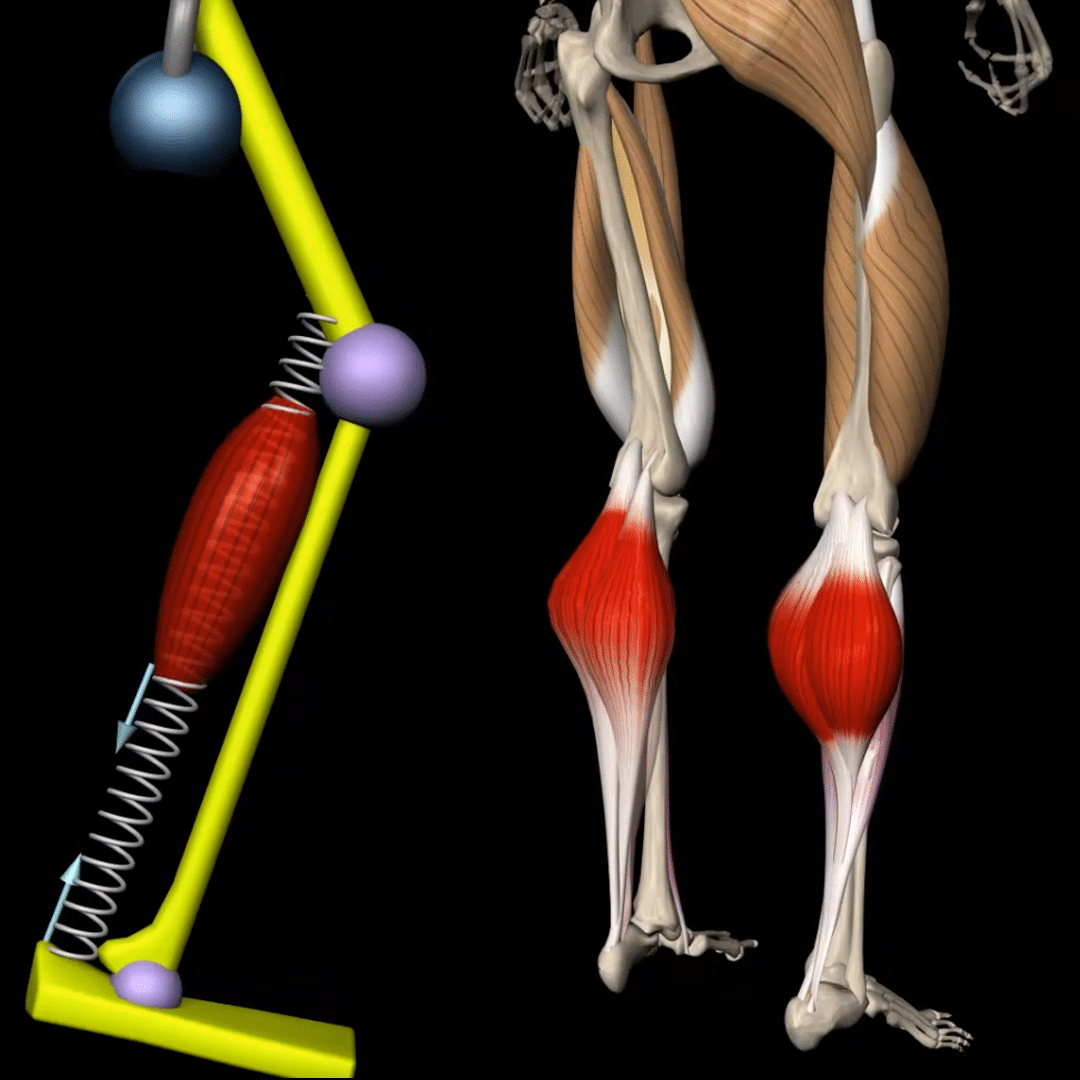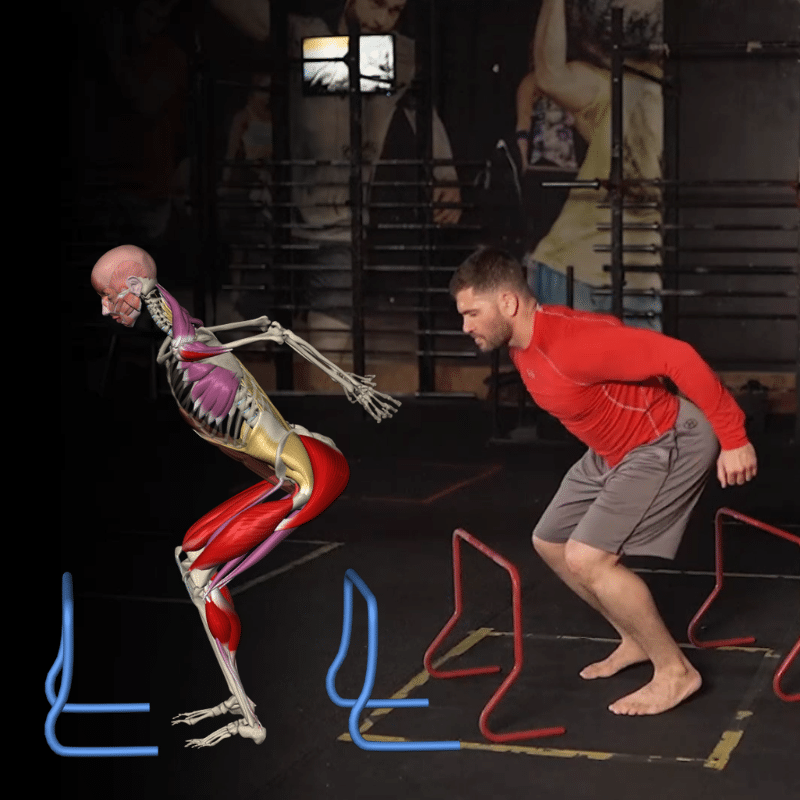Jumping and landing are essential components of many athletic movements. Mastering them can significantly improve performance. One exercise that effectively develops these skills is the hurdle jump and stick. Combining leg strength with control prepares your body for the high-impact demands of plyometric movements. Incorporating the hurdle jump and stick into your routine is a smart choice to improve power and agility.
This Muscle and Motion article explores the hurdle jump and stick exercise, focusing on improving jumping and landing techniques, building eccentric strength, and preventing injuries. It also highlights the differences from the box jump with videos and 3D animations for guidance.
What is the hurdle jump and stick?
The hurdle jump and stick is a powerful exercise designed to enhance jumping technique and improve control during landings. It engages your legs and core while training your body to absorb impact effectively. This exercise also serves as an essential foundation for more advanced plyometric (jump training) movements, helping you safely build the strength and explosiveness needed for high-intensity exercises.
What is plyometrics?
Plyometrics, or jump training, are exercises designed to boost power and explosiveness by generating maximum force in short bursts. These movements combine rapid muscle stretching and contracting at a high intensity. Incorporating plyometrics into your routine can significantly enhance strength, muscle control, balance, jumping ability, speed, and even bone density.
The hurdle jump and stick is an excellent way to develop your jumping and landing skills, serving as a preparatory step for more advanced plyometric exercises. However, due to the high impact of plyometrics, it’s crucial to begin with lower-intensity exercises like the hurdle jump and stick to condition your body properly. Even experienced trainers should limit plyometric sessions to no more than three times per week to allow for adequate recovery.
Want to learn more about plyometrics? Read the blogs Plyometrics – The Science of Explosive Strength and Designing a Plyometric Training Program.

How the hurdle jump and stick enhance jumping and landing skills
The hurdle jump and stick is a standout exercise because it emphasizes explosive takeoffs and controlled landings. As you leap over the hurdle, you activate your leg muscles, core, and arms to generate height. The crucial part comes during the landing, where the focus is on “sticking” the landing—absorbing the impact with your muscles while maintaining control. This trains your body to manage the forces exerted during landing, a key factor in preventing injuries, especially in more advanced plyometric movements.
How to master the hurdle jump and stick
To perform the hurdle jump and stick correctly, jump over the hurdle with high knees and an active arm swing. The aim is to land softly and with control by engaging your muscles and tendons to absorb the impact. Keeping your legs and core engaged throughout the movement ensures you build the strength and stability required for more challenging exercises.
The anatomy of the hurdle jump and stick
The primary goal of this exercise is to develop eccentric strength—specifically, your ability to control and absorb force during the landing phase. This important skill reduces the risk of injury and builds the foundation for more dynamic movements.
Key muscle groups activated during this exercise include:
- Gluteus maximus: Responsible for hip extension and generating the explosive force needed for jumps.
- Quadriceps femoris: Assists with knee extension, crucial for both jumping and sprinting.
- Gastrocnemius and soleus: Control ankle plantarflexion, helping to propel you off the ground.
- Iliopsoas: Acts as the primary agonist during the movement.
- Rectus femoris, tensor fascia latae, and sartorius: Serve as synergists to support the jump.
- Core muscles and gluteus medius: Stabilize the body, especially during the landing phase.
- Hamstrings: Aid in hip extension, contributing to the explosive power of the jump.
- Anterior deltoid: Initiates the arm swing, enhancing jump height and helping to generate more power for the hip and ankle joints beyond simply lifting the center of gravity.
The difference between the box jump and the hurdle jump and stick
While the box jump and the hurdle jump and stick are excellent for developing explosive power, they differ significantly in how they challenge your muscles. The key difference lies in the load during the eccentric phase, which is influenced by gravity on the descent.
In a box jump, the primary focus is on the concentric phase—the upward jump. Since you land on an elevated surface, the impact load is reduced, making the landing phase less challenging. In contrast, the hurdle jump and stick emphasizes the eccentric phase because the landing occurs on the ground. This increased load forces your muscles to decelerate and absorb more force, making it a superior exercise for training controlled landings.
The hurdle jump and stick offer a greater challenge in stabilizing the body during the landing phase, making them ideal for building eccentric strength. Eccentric strength is crucial for absorbing impact and preventing injuries, and it’s an essential component of injury prevention in sports and high-intensity training.
Concentric jump versus countermovement jump
A concentric jump, or a squat jump, focuses solely on the upward movement. In this type of jump, you begin in a half-squat position and explosively drive upwards. While this movement builds power, it does not engage the full stretch-shortening cycle of the muscles, meaning it isn’t considered a true plyometric exercise.
In contrast, a countermovement jump begins with a downward movement, where you bend your knees and hips before springing upwards. This initial downward motion stretches the muscles, which are then immediately contracted to generate more force. This makes it a true plyometric exercise, fully utilizing the stretch-shortening cycle to produce greater power. The countermovement jump is a core exercise for improving both power and agility.
Building a safe progression to plyometrics
Before starting full plyometric exercises, it’s crucial to teach your body to jump and land with stability while gradually enhancing the elastic component of your jumps.
The exercise sequence shown here is an excellent example of how proper preparation can help prevent injuries. This is just one approach, and you can design your exercise sequence based on these principles to build a safe and effective progression.
To get all the tools and guidance you need to create a well-structured plyometric training program, check out the blog: Designing a Plyometric Training Program. This blog provides detailed information on how to safely incorporate plyometrics into your routine, focusing on progression, intensity, and exercise selection to maximize both performance and injury prevention.
At Muscle and Motion, we believe in providing fitness professionals with the tools and knowledge to perform these movements safely and effectively. Our resources, including in-depth videos and 3D animations, offer the perfect guide for mastering exercises like the hurdle jump and stick and progressing to more advanced plyometric training.
Have you ever wondered what makes our anatomical animations so accurate and engaging? Click here to learn about our Quality Commitment and the experts behind our content.
At Muscle and Motion, we believe that knowledge is power, and understanding the ‘why’ behind any exercise is essential for your long-term success.
Let the Strength Training App help you achieve your goals! Sign up for free.


